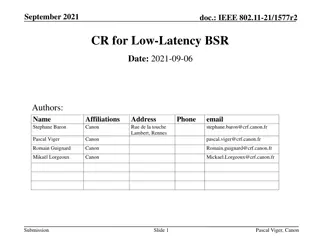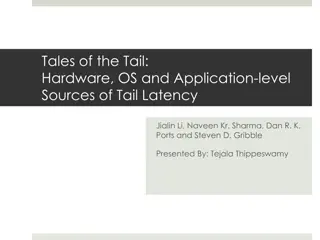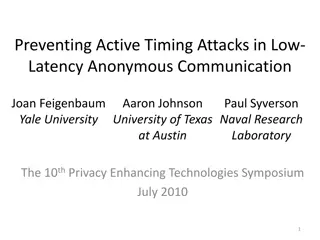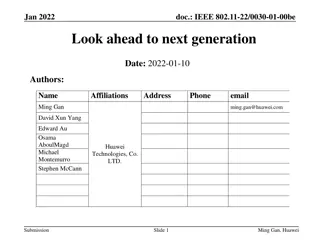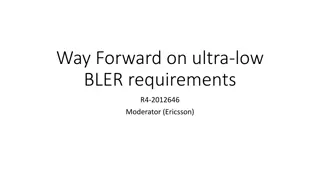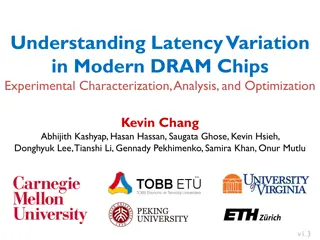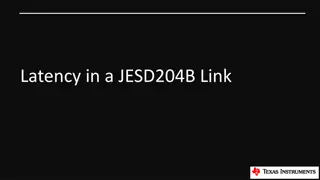
Latency Measurement for IEEE 802.11be Features in January 2020
"Explore the importance of latency measurement for IEEE 802.11be networks addressing low-latency functions and jitter. Discover the necessity of measuring worst-case latency and jitter for real-time applications, with insights into network management and quality of service improvements in Wi-Fi links."
Download Presentation

Please find below an Image/Link to download the presentation.
The content on the website is provided AS IS for your information and personal use only. It may not be sold, licensed, or shared on other websites without obtaining consent from the author. If you encounter any issues during the download, it is possible that the publisher has removed the file from their server.
You are allowed to download the files provided on this website for personal or commercial use, subject to the condition that they are used lawfully. All files are the property of their respective owners.
The content on the website is provided AS IS for your information and personal use only. It may not be sold, licensed, or shared on other websites without obtaining consent from the author.
E N D
Presentation Transcript
January 2020 doc.: IEEE 802.11-19/1942r7 Latency Measurement for 11be Features Date: 2020-01-xx Authors: Name Akira Kishida Company NTT Address Phone Email akira.kishida.fs@hco.ntt.co.jp Yasuhiko Inoue Yusuke Asai Yasushi Takatori Kengo Nagata Xin Zuo Tencent xinzuo@tencent.com Suhwook Kim LG Electronics suhwook.kim@lge.com Kazuyuki Sakoda Sony Kazuyuki.Sakoda@sony.com Mohamed Abouelseoud Mohamed.Abouelseoud@gmail.com Liangxiao Xin Liangxiao.Xin@sony.com Frank Hsu MediaTek frank.hsu@mediatek.com Submission Slide 1 Akira Kishida (NTT)
January 2020 doc.: IEEE 802.11-19/1942r7 Abstract According to EHT PAR [1], the scope of TGbe includes at least one mode of operation capable of improved worst case latency and jitter. As well as IEEE 802.11ax, IEEE 802.11be will use unlicensed spectra, low-latency and jitter functions depend on the radio environments. Therefore, measurement of quality of low-latency and jitter is quite important. This presentation discusses necessity of measurement and report features for IEEE 802.11be low-latency functions. Latency characteristics are affected from contention time and retransmission time (Transmit delay defined in REVmd) greatly, then those should be measured for real-time applications (RTAs). Statistical measurement and report for worst case latency or jitter should be needed, which requires a number of measurement results. Submission Slide 2 Akira Kishida (NTT)
January 2020 doc.: IEEE 802.11-19/1942r7 Problem Statement Latency measurement of Wi-Fi could be essential not only for latency/jitter improvement but also for RTAs, Internet Service Provider (ISP) s and Network operators. In order to maintain the same QoS and manage network, monitoring and adaptation to the network are important. statistics captured/predicted at online mobile gaming servers daily active users tens of millions users connected through Wi-Fi ~ 60% of above bad user experience due to network 20 ~ 40% of above problems located at the Wi-Fi link ~70% of above Submission Slide 3 Akira Kishida (NTT)
January 2020 doc.: IEEE 802.11-19/1942r7 Problem Statement (cont d) Some RTAs (e.g. game app and server) have already integrated adaptive algorithms for network transmission, trying to maintain QoS for users, based on the measurement on Wi-Fi links using other techniques on upper layers. However, Measurement frequency is a trade-off between extra network load and efficiency of algorithm. Measurements are blurred reflections of Wi-Fi links a moment ago (not accurate nor immediate as Wi-Fi built-in measurements) ISPs have no better understanding of what is going on at Wi-Fi side and thus no better solutions to help end-to-end QoS for users. Submission Slide 4 Akira Kishida (NTT)
January 2020 doc.: IEEE 802.11-19/1942r7 Need for Features of Latency Measurement RTA Report [2] indicates various use cases of real-time applications and their requirements. To meet the requirements of each real-time application, we should know how much latency and jitter are generated in the BSS. From the perspective of stable network management, low-latency features in IEEE 802.11be should be controlled based on the results of latency measurement. Latency measurement can offer recognition or prediction of Worst Case for RTA. For example, low-latency queue proposed in [3] can be utilized based on the results of latency measurement. Submission Slide 5 Akira Kishida (NTT)
January 2020 doc.: IEEE 802.11-19/1942r7 Need for Features of Latency Measurement (cont d) Contention time and retransmission time (defined as Transmit delay in REVmd spec) that affect on latency characteristic should be measured at each AP and STA, and statistical information of delay and jitter characteristic should be notified to an AP or networks. RTA STA should have some functions that can measure latency (including contention time and retransmission time). However, concrete method of latency measurement (how AP or STAs measure latency at each side) won't be defined in IEEE 802.11be standard. It can be left for implementation matter. It may be good that AP or STA measure each packet delay within its normal operation (in-service). Moreover, features that notify statistical information of latency measurement should be defined in IEEE 802.11be. Submission Slide 6 Akira Kishida (NTT)
January 2020 doc.: IEEE 802.11-19/1942r7 Time Categorization for Latency Analysis Wi-Fi Time Sensitive Networking (17/1734r1) [4] comprises packet delay as follows. Packet Delay = Queueing Delay + Packet Transmission Time Latency analysis for EHT (19/0762r1) [5] divides packet delay as follows. TW: Contention waiting time Time to transmit previously arrived packets TC: Contention time TR: Additional time for retransmission Time spent for failed transmission TTX: Transmission time for successful data frame and ACK Submission Slide 7 Akira Kishida (NTT)
January 2020 doc.: IEEE 802.11-19/1942r7 Time Categorization for Latency Analysis (cont d) This figure shows an example of divided time categories based on Latency analysis for EHT (19/0762r1) [5] Sending STA Recieving STA Contention time and retransmission time have great impact on latency characteristics for RTA! Queue in Contention start Previous transmission TW: Contention waiting time Backoff Time Busy for another transmission Initial transmission TC: Contention time Backoff (carry over) Transmission failed Backoff Time TR: Additional time for retransmission Contention for retransmission Busy for another transmission TW: Contention waiting time TC: Contention time TR: Additional time for retransmission TTX: Transmission time for successful data frame and ACK Backoff (carry over) TTX: Transmission time for successful data frame Successful data transmission and ACK and ACK Submission Slide 8 Akira Kishida (NTT)
January 2020 doc.: IEEE 802.11-19/1942r7 Latency Measurement and Notification Additional measurement functions that can measure contention time and retransmission time should be required. Though it can be left for implementation matter, all RTA STAs should have latency measurement functions and we should make agreement for that. Statistical information about latency and jitter should be measured and notified to determine whether target RTA can be utilized or not. Notification function of the information should be defined in IEEE 802.11be. Statistical information: Average latency for certain period, worst case latency and jitter, et, al. Submission Slide 9 Akira Kishida (NTT)
January 2020 doc.: IEEE 802.11-19/1942r7 Conclusions To obtain more detailed availability of low-latency and jitter features, additional measurement function(s) for contention time, retransmission time will be needed. To judge whether current RTA is applicable or not, statistical information about latency and jitter should be measured and notified as well. To control low-latency features in 11be properly, RTA STAs should have latency measurement and notification features. However, concrete method of latency measurement will be implementation matter. Submission Slide 10 Akira Kishida (NTT)
January 2020 doc.: IEEE 802.11-19/1942r7 References [1] 802.11/18-1231r1 EHT draft proposed PAR [2] 802.11/19-0006r6 RTA report draft [3] 802.11/19-1524r0 Latency enhancement for EHT [4] 802.11/17-1734r0 Wi-Fi Time Sensitive Networking [5] 802.11/19-0762r1 Latency analysis for EHT Submission Slide 11 Akira Kishida (NTT)
January 2020 doc.: IEEE 802.11-19/1942r7 Appendix TM and FTM IEEE 802.11v (already merged to IEEE 802.11-2016) defines timing measurement (TM) and fine timing measurement (FTM) as parts of WNM (Wireless Network Management). However, TM and FTM are features for timing synchronization or location detection originally. Then, WNM offers measurement functions only for medium access delay of successful transmission. Submission Slide 12 Akira Kishida (NTT)
January 2020 doc.: IEEE 802.11-19/1942r7 Existing Features of Timing Measurement: WNM WNM (Wireless Network Management) defined in IEEE 802.11-2016 establishes Timing Measurement (TM) / Fine Timing Measurement (FTM) procedures. However, timing Measurement in WNM can measure only medium access delay of successful transmission (portion of TTX). The whole intention of TM and FTM is not latency measurement but timing synchronization or location detection. TW: Contention waiting time TC: Contention time TR: Additional time for retransmission TTX: Transmission time for successful data frame and ACK Submission Slide 13 Akira Kishida (NTT)
January 2020 doc.: IEEE 802.11-19/1942r7 Timing Measurement procedure in WNM Timing Measurement is initiated by transmitting Timing Measurement Request frame. Timing Measurement frame and corresponding Ack frame are used to measure time difference between STAs. Timing Measurement frame is an Action frame. Measurement period Submission Slide 14 Akira Kishida (NTT)
January 2020 doc.: IEEE 802.11-19/1942r7 Scope of Timing Measurement in WNM Timing Measurement in WNM can measure only medium access delay of successful transmission (portion of TTX). Sending STA Recieving STA Previous transmission TW Backoff Time Busy for another transmission TC However, real time applications are greatly affected by contention time (TC) and retransmission time (TR). Contention time increases according to transmissions by other STAs. Retransmission affects immediately n increase of latency. Need to measure for RTA in IEEE 802.11be Backoff (carry over) Backoff Time TR Busy for another transmission Backoff (carry over) TT X Measurement period by timing measurement defined in WNM Submission Slide 15 Akira Kishida (NTT)

